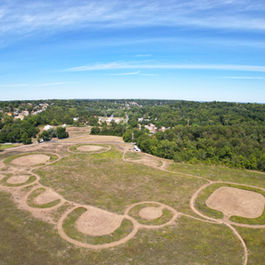Resting less than one mile from the banks of the Ohio River, ten miles south of Wheeling in Moundsville, West Virginia, lies the Grave Creek Mound, an ancient earthwork with truly fascinating history. Built by the Adena, an Early Woodland period Native American culture, sometime around 250 BC, the mound measures more than 60-feet in height with a base of roughly 240-feet in diameter making it the largest surviving conical burial mound in the United States.

In 1770 an early settler named Joseph Tomlinson discovered the mound and subsequently purchased a tract of land that included not only the Grave Creek Mound, but several other burials mounds that once stood in the area. In 1803, during their Corps of Discovery Expedition, Lewis & Clark came upon the mound and noted:
“...This remarkable mound of earth stands on the east bank of the Ohio 12 miles below Wheeling and about 700 paces from the river, as the land is not cleard the mound is not visible from the river—this mound gives name to two small creeks called little and big grave creek which passing about a half a mile on each side of it & fall into ohio about a mile distant from each other the small creek is above, the mound stands on the most elevated ground of a large bottom containing about 4000 acres of land…”
The first major attempt to investigate the Grave Creek Mound was made in 1838 by two descendants of Joseph Tomlinson and a man named Thomas Biggs. They signed a 30-year lease with the land owner, agreeing to tunnel into the mound and construct a museum to display artifacts. On March 19, 1838, tunneling commenced at the north base of the mound. Excess dirt from the excavation was carted out and spread over the last remnants of the circular ditch that the Adena had dug 2,000 years prior. After a few weeks of digging, a vault eight feet by twelve feet square and seven feet deep was revealed. Upright logs lined the sides and covered the roof, which was also covered with river cobblestones. Upon accessing the bottom vault, excavators discovered two skeletons, one male and one female. The male skeleton was surrounded by hundreds of disk shell beads and found with an expanded center-gorget of undetermined material.

In June, a second vault measuring eighteen feet by eight feet was discovered above the lower. This vault included one adult male skeleton surrounded by hundreds of shell beads, rectangular mica pieces, five copper arm bands, and a diamond shaped limestone gorget. A year later a museum was opened in the enlarged lower burial tomb with a twenty-five cent admission charge.
In 1858, a man named Wylie Oldham purchased the mound and operated a saloon on the top. The grounds around the mound would soon become the site of the county fair with a race track built around it. In 1863, cannons were placed on top and the mound served as a Union artillery station during the Civil War. 1874 brought more change to the mound when George McFadden purchased the mound for $1,760, planted corn around its base and a dance platform on top. Nearly twenty years later McFadden considers leveling the mound and selling the land for town lots, but doesn't. His son, RJ McFadden, inherits the mound in 1906 and announces that it will be destroyed unless sold for $20,000. A 1909 fundraising campaign led by teachers and students nets $1,400 and the state of West Virginia ponies up the remaining $18,600 to acquire the mound from McFadden.

In 1917, the mound was featured in a promotion for the town. Newspapers wrote of it: "The mammoth Pre-Historic Mound, largest in the world. It was built by an extinct race; is 72 feet high, and occupied almost a whole city square."

In 1948, a small stone gift shop was constructed near the south base of the mound by local penitentiary inmates to sell souvenirs made by the prisoners. Four years later an expansion of the gift shop was built and a museum was opened displaying hundreds of prehistoric artifacts. In 1964 the mound was designated a National Historic Landmark and later placed on the National Register of Historic Places. Finally, in 1978 the Delf Norona Museum was finished and opened to the public. Today, the museum displays many of the most important archaeological discoveries in the state of West Virginia.
The lower gallery of the museum contains hundreds of Native American artifacts, a cast skeleton of a stegodon, the state fossil of West Virginia, colonial-era artifacts, and much more.

Also in the lower gallery, visitors can view a dug-out canoe similar to those used by the Adena thousands of years ago.

A series of ten panels near the back of the museum guide visitors through roughly 12,000 years of human habitation in West Virginia from how various indigenous peoples built homes, hunted and foraged for food, harvested crops, etc. The Clifton Heights Petroglyph, a sandstone slab collected from a hillside north of Wheeling depicting human elements and animal forms, can also be found in the lower gallery. Most petroglyphs found in West Virginia are believed to have been created during the Late Prehistoric or Protohistoric periods (1200-1690 AD).

The upper gallery focuses on the Adena way of life and the Grave Creek Mound. About 1000 B.C. marks the beginning of a major change in North America. Termed the Woodland Period and lasting until about 1200 A.D., this era is characterized by new ways of living, including permanent settlements and plant domestication. The first group of people to develop this unique way of life were the Adena, from about 1000 B.C. to about 200 A.D in the region of present-day Ohio, Indiana, West Virginia, Kentucky, and parts of Pennsylvania and New York. A replica Adena living structure, hundreds of Adena artifacts, and educational panels can all be found in the upper gallery. All of this and more make up the Grave Creek Mound Archaeological Complex, one of the true gems in the state of West Virginia.
_edited.png)













































Comments